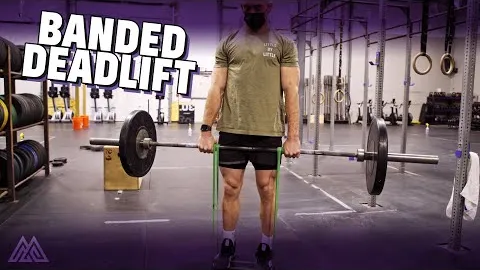

Are you looking to take your strength training routine to the next level? If so, incorporating banded deadlifts into your workouts might be just what you need. This exercise is a variation of the traditional deadlift that adds an extra level of difficulty and requires the use of resistance bands. In this comprehensive guide, we will dive into the mechanics of the banded deadlift, its benefits, and tips on how to properly execute it.
The banded deadlift is a compound exercise that targets multiple muscle groups simultaneously, offering a comprehensive workout for both the upper and lower body. In addition to engaging the core muscles, the banded deadlift primarily targets the glutes, hamstrings, quadriceps, and the muscles of the lower back.
Increased resistance: The incorporation of resistance bands provides an extra level of resistance throughout the entire range of motion. This increased resistance helps in building strength and muscle mass, allowing you to progress faster in your fitness journey.
Enhanced stability: The bands provide a dynamic resistance that challenges your balance and stability. This increased demand on stability muscles can translate into improved performance in other exercises and daily activities.
Reduced risk of injury: Banded deadlifts activate stabilizing muscles, enhancing your ability to maintain proper form during the movement. This, in turn, reduces the risk of injuries associated with poor lifting mechanics.
Improved grip strength: The resistance offered by the bands requires you to have a stronger grip to maintain control of the barbell. Over time, this can lead to improved grip strength, which is beneficial for various athletic activities.
To perform the banded deadlift effectively and safely, follow these steps:
Setup: Begin by attaching the resistance bands to the barbell. Step onto the bands with your feet shoulder-width apart, ensuring that the bands are evenly distributed on both sides of the barbell. Position the bands at a height suitable for your fitness level.
Grip: With the barbell on the ground, assume a shoulder-width overhand or mixed grip. Ensure that your grip is secure and that your wrists are in a neutral position.
Positioning: Brace your core, engage your glutes, and maintain a neutral spine throughout the movement. Push your hips back as you bend your knees, keeping your shoulders slightly in front of the barbell.
Lift: Drive through your heels, extending your hips and knees simultaneously. Keep the barbell close to your body as you stand up, maintaining a straight and vertical back.
Lowering: Lower the barbell under control by pushing your hips back and bending your knees. Keep the tension in the bands throughout the entire range of motion.
To optimize the effectiveness of your banded deadlifts, consider the following tips:
Progress gradually: Start with lighter resistance bands and gradually increase the tension as you become more comfortable with the exercise. This will help avoid unnecessary strain on your muscles and joints.
Maintain proper form: Focus on maintaining a strong and stable core throughout each repetition. Keep your shoulders back, chest up, and back straight to prevent any rounding or excessive forward lean.
Engage the right muscles: Concentrate on activating the target muscles, including the glutes, hamstrings, and lower back. Squeeze your glutes at the top of the movement for added engagement.
Control the descent: Avoid bouncing the barbell off the ground. Lower it under control, keeping tension on the bands, to maximize the benefits of the exercise.
Seek professional guidance: If you are new to strength training or are unsure about your technique, consider seeking guidance from a qualified fitness professional. They can help ensure that you are performing the banded deadlift correctly and safely.
In conclusion, incorporating banded deadlifts into your strength training routine can provide numerous benefits, including increased resistance, enhanced stability, reduced risk of injury, and improved grip strength. By following the proper execution and considering the tips provided, you can effectively and safely incorporate this exercise into your fitness regimen. Remember to start with lighter resistance and gradually progress, emphasizing proper form and engaging the target muscles. Take your training to the next level with banded deadlifts - you won't be disappointed!
If you're looking for a gym, fitness club or yoga studio, you've come to the right place.
You can find information about gyms in your area. Browse catalog of gyms and find gyms with classes which are you looking for.
On gym page you can find simple information like address, phone or website. You can find list of available classes. You can check availability of personal training or small group classes. On place page you can also see information about open hours.
You can find gyms near you with amenities, courts, studios and equipments.
Use our map to find gym at your city or district.
In Gym Navigator you can find list of exercises with movies for many body parts.
You can browse exercises catalog and find exercises the best of you.
You can also find exercises grouped into workout plans, which you can use to improve you body. Each routine show you exercises one by one and give you possibility to count you progress and count down rest time.